The building was constructed in the 1890's and officially opened for use in November 1894. We began with the downstairs executive chambers, learning about the government, the building and the state's history. Colorado became a state in 1876, exactly 100 years after the country was founding, giving it the name of the Centennial State.

Signing up for the tour next to the state seal


Executive chambers

The Office of the Treasurer

Portraits of some former governors
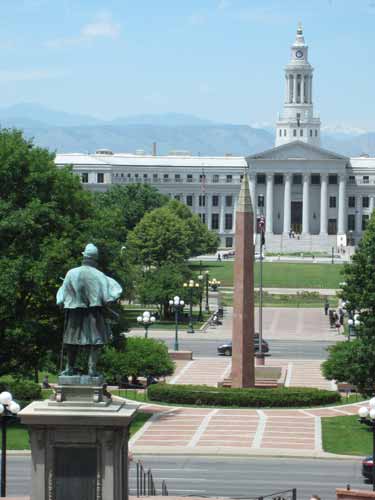
A view across the way of the City and County Building (aka City Hall)

The red stone is Colorado Rose Onyx, a rare rose marble from a quarry in southern Colorado. Actually, the capitol building consumed the entire known supply. White Yule Marble from quarries in southeastern Colorado was used for the floors.

The "Key to the state of Colorado," presented to the governor in 1984.

Our tour guide explains a tapestry depicting famous women of Colorado.

The presidential portraits usual hang under the dome, but due to the renovations, they have been moved down here for a while.
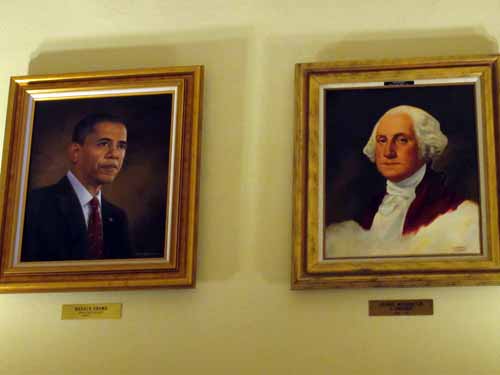
Our current present, Barack Obama, to our founding one, George Washington.

A wall of murals...

... depicting different aspects of past Colorado life.
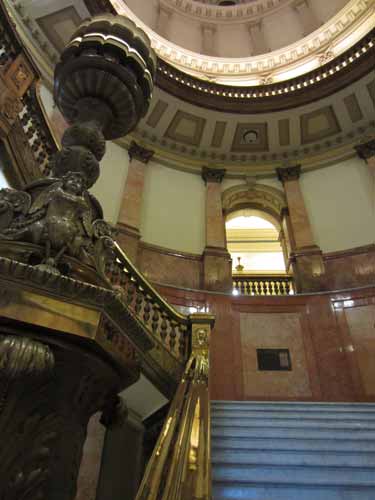
Heading upstairs
On the second floor, we briefly peeked into a meeting room for the House of Representatives.

The second floor
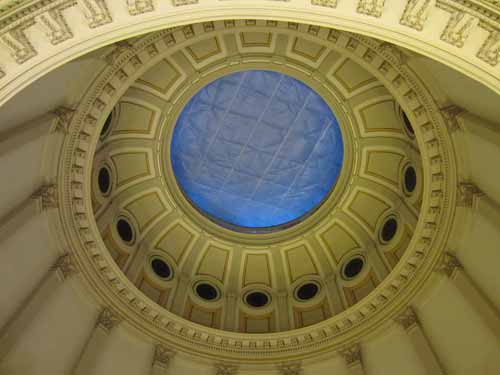
Looking up at the dome...

... and down at the stairs

All the shiny metal is brass, not gold. It is polished every day to keep it looking nice.
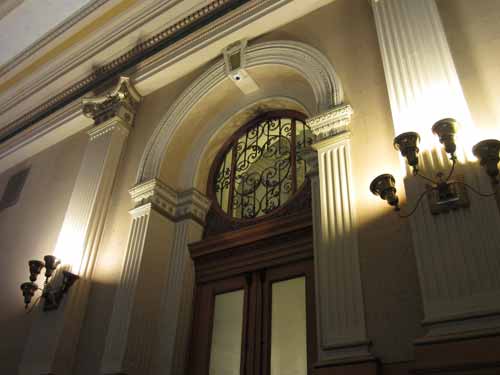
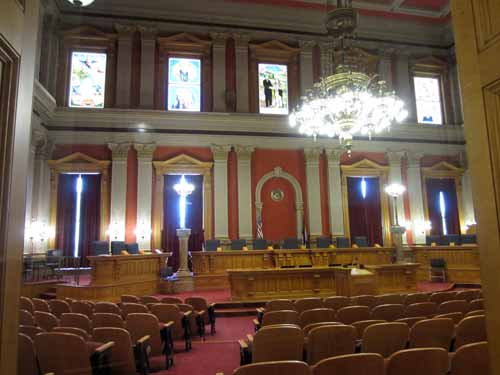
The House of Representatives room
We continued up to the third floor and took a in the Senate Gallery balconies. We were joined by another tour guide who specialized in this history.

The third floor
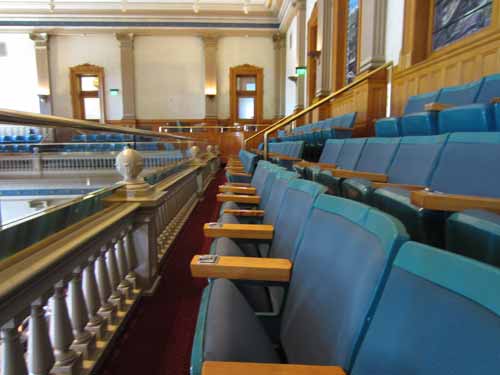
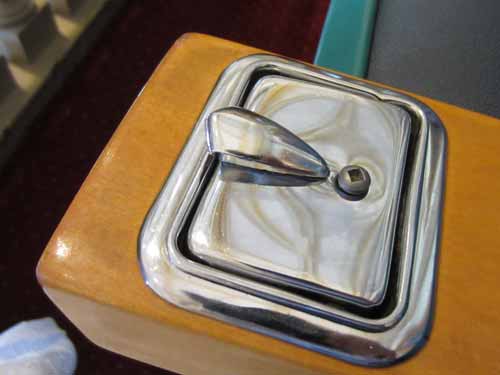
Oooh... not much use for these anymore!

Looking down over the Senate Gallery, which was having several of its stained glass windows replaced.
The guide told us that under the giant desk in the center (now covered with plastic), there is a large safe. In the old days, all bills were written up by hand. As these documents were often hundreds of pages long, there was usually only one copy. It was hence very easy to "make a bill go away" by simply stealing it. No paperwork, no bill, nothing to vote on, nothing to potentially become a law. So the safe was added to prevent that from happening. During a previous remodel many years ago, however, the safe was moved and numerous bills were found crumpled up beneath and behind it. Who knows how different this state potentially could have been!?
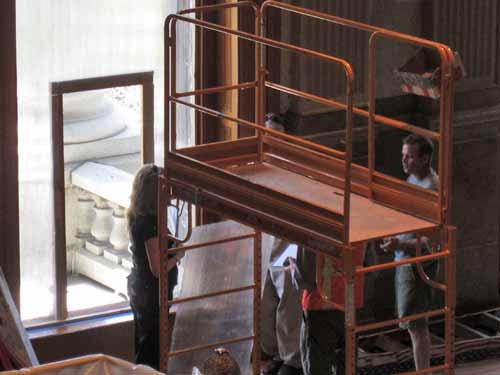
Replacing the stained glass window with a temporary plastic one

The chandelier weighed 1,500 - 2,000 pounds and could be lowered down by a giant crank hidden in the ceiling every couple of years to replace the light bulbs. If you look carefully, on top of each light bulb is a gas light since at the time the chandelier was made, electricity was a "new" thing and they weren't sure if it was just a fad.
Our tour then ran out of time but we were allowed to visit the House Gallery on our own.
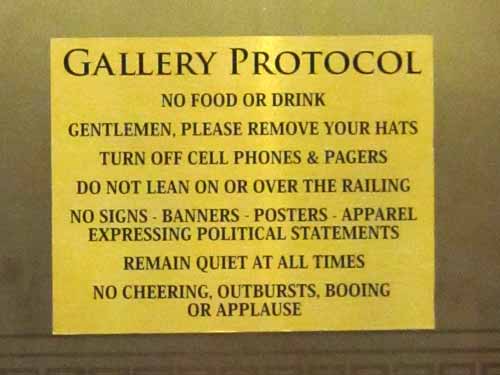

A different color scheme

All the proceedings were recorded and could be watched live on one of our local tv channels.
The dome was closed, but the attic (called Mr. Brown's Attic) was open. This contained numerous displays containing all sorts of interesting facts about the state and its capitol building.
Henry Cordes Brown was a contractor and developer who homesteaded Brown's Bluff in 1860, to the east of the growing city of Denver. In 1867, he donated 10 acres of his land for the site of a capitol building. He expected that many would want to build their mansions next to it. And he was right... except for the fact that it took almost 20 years before work on the capitol began. In the meantime, Brown had grown upset with the delays and wanted his land back. But he lost. And he eventually lost all his wealth too. But he will always be remembered for his contribution.

Henry Brown
Some interesting facts:
- The original dome was copper. It was gilded in gold for the first time in 1908, and again in 1950, 1980 and 1991. The current dome is covered with 47.5 ounces of gold leaf from Italy. The gold symbolizes the state's Gold Rush days which began in 1859 when the "Gregory Lode" was discovered near Central City.
- Of the 647,000 square feet which makes up the building, only 35% is for offices and workspace. There are 160 rooms.
- This is the nation's third highest capitol (at 5,280 feet in elevation). New Mexico and Wyoming are higher.
- The building weighs about 300 million pounds. The cornerstone alone is 20 tons and took 20 mules to haul it. The 122 columns are of cast iron and weight 1.7 tons each.

There is soooooo no way I would ever be up there!
- The Rose Onyx is the only one of its kind in the world. The small deposit (near Beulah) was depleted of all usable stone which went exclusively into the construction of the capitol.
- Elijah Myers, the architect, thought it wouldn't look good for coal to be seen being delivered, so he designed a tunnel to the subbasement. A heating plant would be located there and the coal could be delivered via a railway on coal cars. Since then, more tunnels were built connecting the building to 5 other state buildings in the area.
- The state Moto is Nil Sine Numine (Nothing without the deity); the state animal is the Rocky Mountain bighorn sheep; the state bird is the Lark Bunting; the state fish is the Greenback Cutthroat trout; the state flower is the columbine; the state fossil is the Stegosaurus, the state insect is the Colorado hairstreak butterfly, the state tree is the Colorado blue spruce...

Never knew this before, but here it is... (also, we have a state tartan??)
Where the snowy peaks gleam in the moonlight,
Above the dark forests of pine,
And the wild foaming waters dash onward,
Toward lands where the tropic stars shine;
Where the scream of the bold mountain eagle
Responds to the notes of the dove
Is the purple robed West, the land that is best,
The pioneer land that we love.
Chorus
Tis the land where the columbines grow,
Overlooking the plains far below,
While the cool summer breeze in the evergreen trees
Softly sings where the columbines grow.
The bison is gone from the upland,
The deer from the canyon has fled,
The home of the wolf is deserted,
The antelope moans for his dead,
The war whoop re-echoes no longer,
The Indian's only a name,
And the nymphs of the grove in their loneliness rove,
But the columbine blooms just the same.
Let the violet brighten the brookside,
In sunlight of earlier spring,
Let the fair clover bedeck the green meadow,
In days when the orioles sing,
Let the golden rod herald the autumn,
But, under the midsummer sky,
In its fair Western home, may the columbine bloom
Till our great mountain rivers run dry.

A model of the building

All seems peaceful and safe, when suddenly.... oh no!! It's...

... Danzilla!

This large structure houses one of the cranks that raises and lowers the chandeliers.
Numerous suggestions were submitted as to what the capitol building should look like, ranging in price from $25,000 to 10 million dollars. Eventually a price of one million dollars was agreed upon. The final actual cost reached $2.7 million, due to the demand for only the finest materials.

It could have looked like this...

Or had a top like this.

The original bill
History of the area:
The Utes are the longest continuous residents of Colorado, with the Cheyenne and Arapaho moving in later. With the discovery of gold, the white man flooded the area. Many left disappointed but others set up businesses and claimed homesteads... all on land that wasn't theirs. Yet through treaties and military force, they eventually claimed the land for themselves.



Early Denver
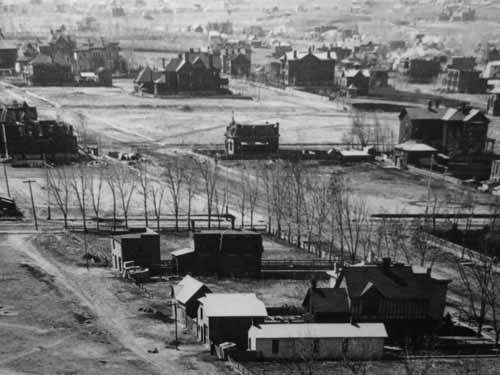

In 1904, President Theodore Roosevelt gives a speech while standing on a chair so the crowd of 40,000 people might see him better.

The coffin of William "Buffalo Bill" Cody was displayed in the first floor rotunda in 1917. 18,000 mourners filed past to pay their final respects while yet another 12,000 were turned away at the end of the day.

Aviator Charles Lindberg drives past the capitol in 1927, after his historic flight across the Atlantic Ocean.

Examples from a 1890 time capsule: artist's rendering of the capitol, a cane made from part of the keel of the USS Constitution, copy of the US and state constitutions, most recent map of Colorado, gold and silver coins, impression of the state seal, US flag, holy bible.
Examples from a 1990 time capsule: tapes of tv shows, sports team memorabilia, Denver phone directory, current price list for a local dentist, disposable camera, Celestial Seasonings tea, beer, wine, whiskey, Yoplait yogurt cups, snow skis, bike shorts.
We left the attic and made our way back downstairs. We made sure to take another look over the railing at the long drop down to the marble stairs below. On the bottom stair, there is a large crack. According to our tour guide, someone once jumped to their death, cracking the stair when they landed. She didn't have any more details than that unfortunately, so I can't share the how's and why's.

Looking over the edge

A long drop with a sudden stop

Dan recreated the scene... except for perhaps the stifled smile!
We walked around outside to the west entrance. Colorado has the honor of having the only state capitol building situated at exactly one mile above sea level (or 5,280 feet or 1,609 meters). To honor this, in 1909 a brass plaque was made to mark the 15th step. After it was stolen four times, in 1947 officials had the words ''One Mile Above Sea Level' carved directly into the step.
Unfortunately things change, including elevations. New technology and a fluctuating sea level eventually caused the words to rest at 5,283.03 feet above sea level. So in 1967, engineers determined that a new marker should be placed on the 18th step.
And as time has a funny way of doing things... yet again things changed, and in 2003, a third geodetic marker was placed on the 13th step.... along with the joke that perhaps it should include the word "about" next to it.
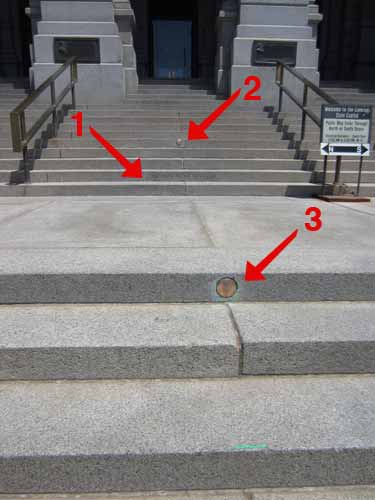
Number 1: the 15th step with "One Mile Above Sea Level"
Number 2: the 18th step with the 1967 marker
Number 3: the 13th step with the 2003 marker


